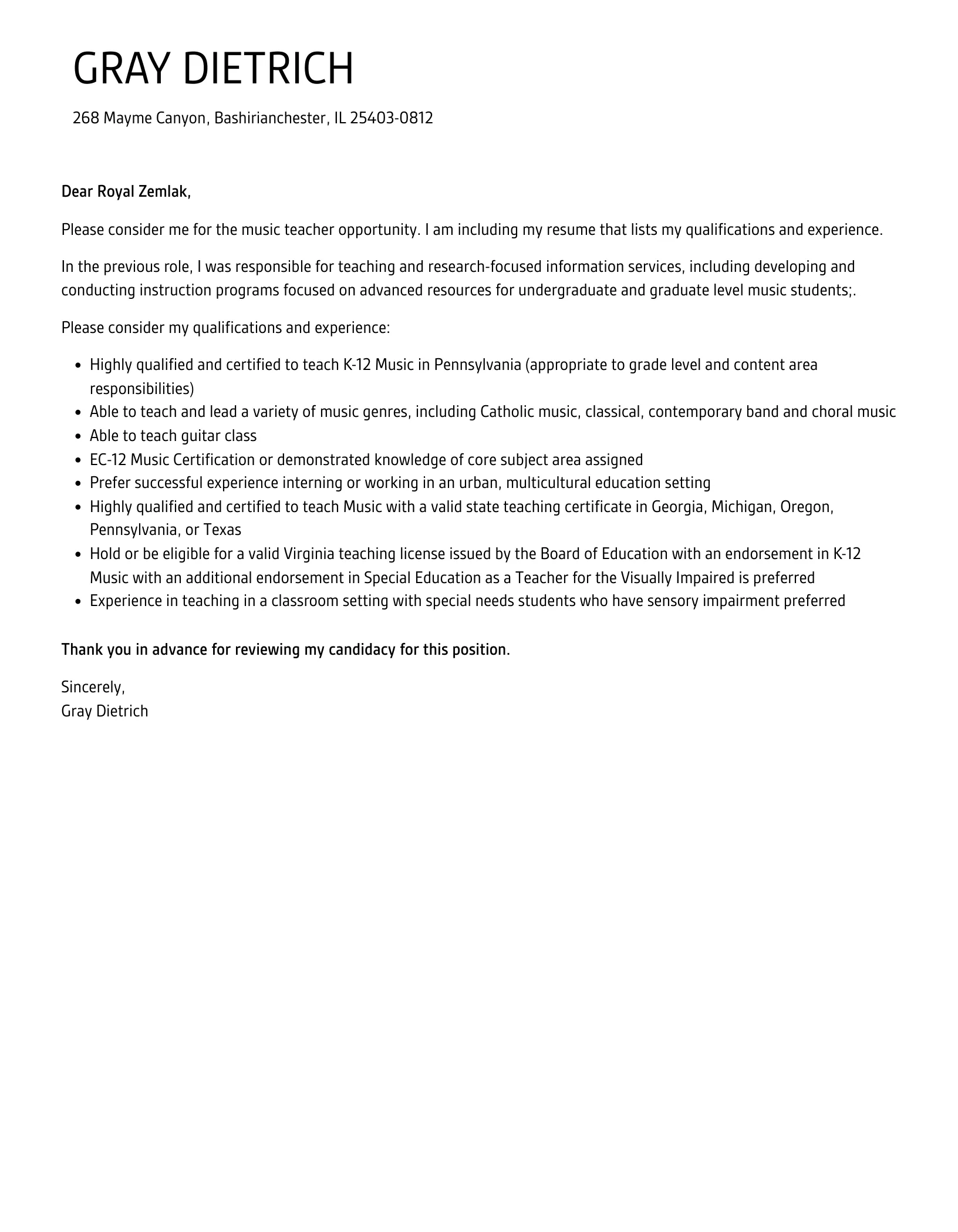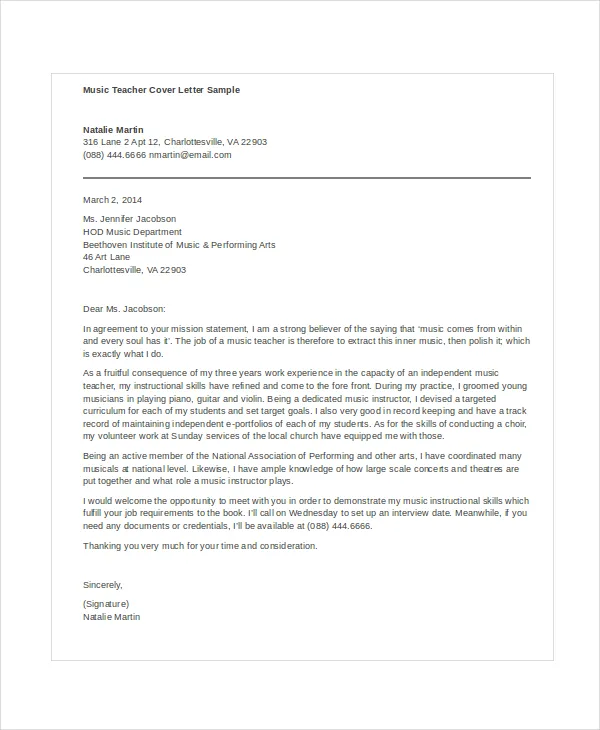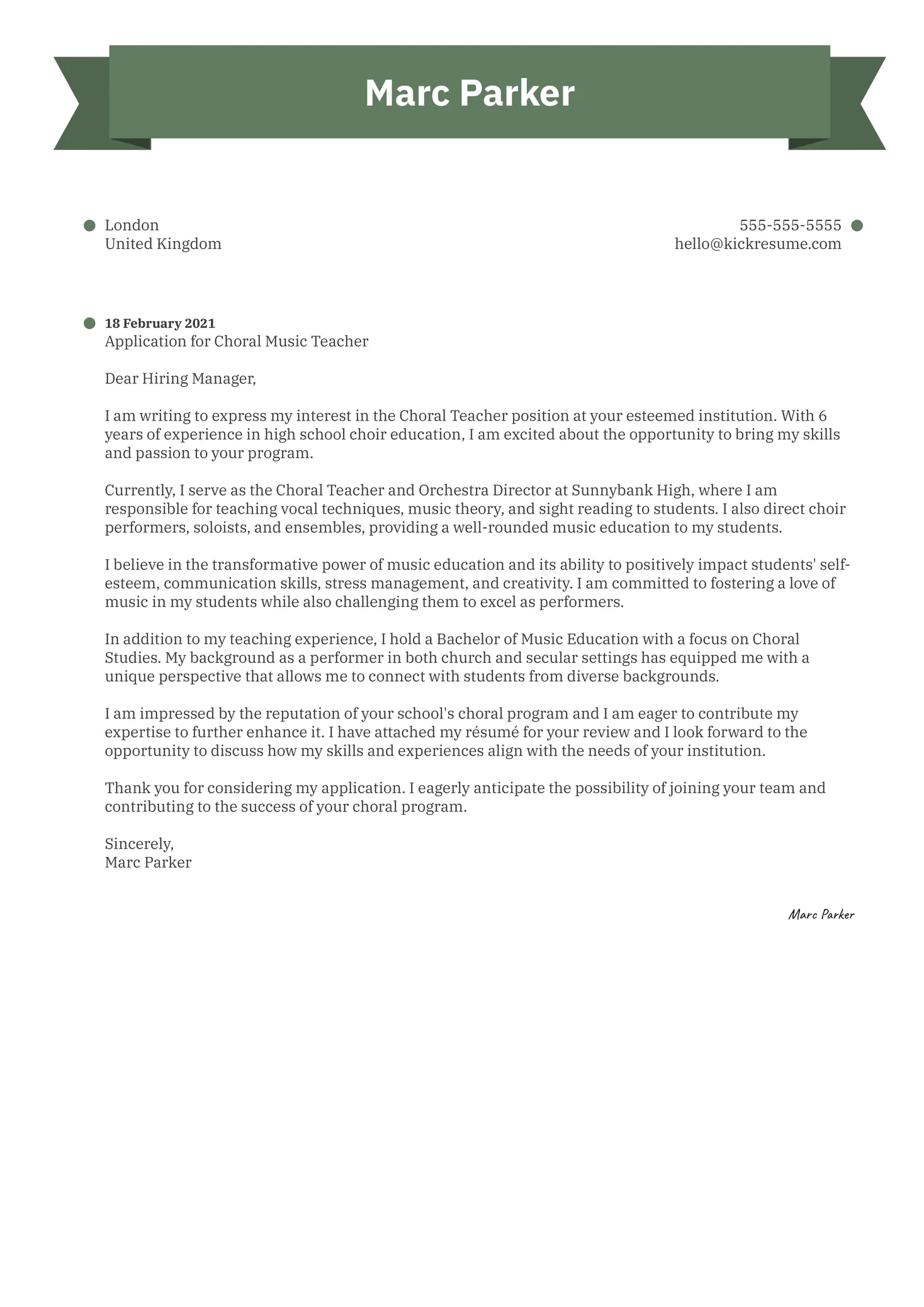Why Your Music Teacher Cover Letter Matters
A compelling music teacher cover letter is your first opportunity to make a lasting impression on a potential employer. It’s more than just a formality; it’s your chance to showcase your passion, qualifications, and personality, setting you apart from other applicants. In a competitive job market, a well-crafted cover letter can be the deciding factor in whether you land an interview or are overlooked. It allows you to personalize your application and demonstrate your genuine interest in the specific teaching position and the school’s values. By highlighting relevant experiences and skills, you can paint a vivid picture of your potential contributions to the music program. Therefore, investing time and effort into creating a standout cover letter is crucial for any aspiring music teacher looking to secure their dream job and start making a positive impact in the musical lives of students.
Highlight Your Passion for Music
Your cover letter should immediately convey your deep-seated passion for music and music education. This is your opportunity to share what drives you, what inspires you about teaching music, and why you’re excited about the prospect of sharing your knowledge and enthusiasm with students. Describe your personal musical journey – what instruments you play, what genres you’re passionate about, and what aspects of music education resonate with you the most. Perhaps you’re captivated by the transformative power of music or the joy of seeing students discover their musical talents. Maybe you have a specific teaching philosophy or a vision for how music can enrich students’ lives. Articulate these feelings with genuine emotion and sincerity. Remember, passion is contagious, and showing your enthusiasm will make your application memorable and persuasive to potential employers who are looking for dedicated teachers.
Showcase Your Teaching Experience

Provide a detailed overview of your teaching experience, highlighting your roles, responsibilities, and the types of students you’ve worked with. If you have extensive experience, focus on the most relevant and impactful positions, and be sure to include details such as the grade levels, instruments, or music genres you taught. Describe your teaching methodologies and techniques. Do you incorporate specific pedagogical approaches, such as the Kodály method, the Orff approach, or Suzuki principles? Explain how you differentiate instruction to meet the diverse needs of your students. Include information about your experience with various age groups and skill levels, and demonstrate your ability to adapt your teaching style to suit different learning styles. Focus on the measurable outcomes of your teaching. Did your students improve their performance skills, achieve higher grades, or participate in successful concerts or competitions? Always try to quantify your achievements to showcase your effectiveness as an educator.
Quantify Your Achievements
Instead of merely listing your responsibilities, use concrete data to illustrate your accomplishments. This could include student test scores, the number of students who participated in music programs, or any awards or recognition your students have received. For example, instead of saying ‘Improved student performance,’ state ‘Increased student participation in school concerts by 30% in one year.’ If you’ve successfully implemented a new curriculum or program, include details about its impact. Did it lead to greater student engagement, improved grades, or a better understanding of music theory? Quantify your accomplishments by using numbers, percentages, and specific examples to demonstrate the tangible results of your teaching efforts. This will show potential employers that you not only possess the skills to teach music but also have a proven track record of success and the ability to make a positive difference in students’ lives.
Tailor Your Cover Letter to the School
Research the school and its music program. Show that you’ve taken the time to understand their specific needs and values. Visit their website, read about their mission statement, and familiarize yourself with their curriculum, music ensembles, and any special programs they offer. If possible, attend a school concert or event to observe the students and the music department in action. Address your cover letter to a specific person, such as the music department head or the principal. This shows you’ve done your homework and are genuinely interested in the position. In your cover letter, specifically mention aspects of the school that appeal to you. Refer to their music program, mention any unique initiatives, and explain how your skills and experience align with their requirements. Demonstrate that you understand their needs and can contribute meaningfully to their music education efforts.
Proofread and Perfect Your Cover Letter

Before submitting your cover letter, carefully proofread it for any grammatical errors, spelling mistakes, or typos. A polished cover letter demonstrates your attention to detail and professionalism. Read your cover letter aloud to check for clarity and flow. Ensure that your sentences are concise and easy to understand. Ask a friend or mentor to review your cover letter and provide feedback. They may identify areas for improvement or catch errors that you missed. Make sure the formatting is consistent, using a professional font and appropriate spacing. Save your cover letter in a professional format, such as PDF, to ensure it is displayed correctly on any device. Double-check all contact information, including your email address and phone number. A flawless cover letter is essential for making a positive impression and increasing your chances of landing an interview.
Essential Elements of a Music Teacher Cover Letter
Contact Information and Salutation
At the top of your cover letter, include your full name, address, phone number, and email address. Be sure your email address is professional and reflects your identity. Then, address your cover letter to the hiring manager or music department head by name if possible. Use a formal salutation such as “Dear Mr./Ms./Mx. [Last Name].” If you are unsure of the name, use a general greeting like “Dear Hiring Committee” or “To Whom It May Concern.” Remember to always maintain a respectful and professional tone, setting the stage for a positive first impression.
Opening Paragraph

In the opening paragraph, state the position you are applying for and where you saw the job posting. Then, immediately grab the reader’s attention by expressing your enthusiasm for the role and the school. Briefly highlight your key qualifications or a specific accomplishment that makes you stand out. State your intention to provide detailed information about your experience and how it matches the school’s requirements. This will immediately set the stage for what you will cover in the body of the letter and entice the reader to continue reading. Make sure your tone is engaging and enthusiastic, to convey your genuine interest in the position and the school.
Body Paragraphs
Use the body paragraphs to showcase your qualifications, experience, and skills in detail. Focus on the most relevant information that demonstrates your ability to succeed in the role. Use specific examples and quantifiable achievements to back up your claims. Discuss your teaching philosophy, your ability to adapt your teaching style, and your experience with different musical genres and instruments. Explain how you can contribute to the school’s music program and what you can bring to the team. Relate your skills to the specific needs of the school and the job description. Highlight relevant coursework, certifications, or workshops to demonstrate your commitment to continuous improvement and professional development. Organize the information logically, using concise and clear language to convey your message effectively.
Closing Paragraph
In the closing paragraph, reiterate your interest in the position and express your enthusiasm for the opportunity. Thank the hiring manager for their time and consideration. State your availability for an interview and provide your contact information again. Include a call to action, such as encouraging the hiring manager to contact you at their earliest convenience. End your cover letter with a professional closing, such as “Sincerely,” or “Respectfully,” followed by your typed name. Ensure the tone is confident and professional, leaving the reader with a positive and memorable impression of your candidacy.
